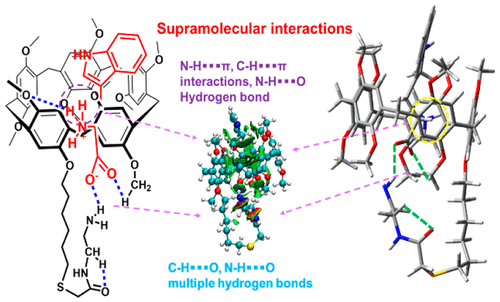当前位置:
X-MOL 学术
›
J. Phys. Chem. A
›
论文详情
Our official English website, www.x-mol.net, welcomes your
feedback! (Note: you will need to create a separate account there.)
N-(2-Aminoethyl)-2-(hexylthio) Acetamide-Functionalized Pillar[5]arene for the Selective Detection of l-Trp through Guest-Adaptive Multisupramolecular Interactions
The Journal of Physical Chemistry A ( IF 2.7 ) Pub Date : 2020-11-12 , DOI: 10.1021/acs.jpca.0c08367 You-Ming Zhang 1, 2 , Qing-Yu Yang 1 , Xiao-Qiang Ma 1 , Hong-Qiang Dong 1 , Yun-Fei Zhang 1 , Wen-Li Guan 1 , Hong Yao 1 , Tai-Bao Wei 1 , Qi Lin 1
The Journal of Physical Chemistry A ( IF 2.7 ) Pub Date : 2020-11-12 , DOI: 10.1021/acs.jpca.0c08367 You-Ming Zhang 1, 2 , Qing-Yu Yang 1 , Xiao-Qiang Ma 1 , Hong-Qiang Dong 1 , Yun-Fei Zhang 1 , Wen-Li Guan 1 , Hong Yao 1 , Tai-Bao Wei 1 , Qi Lin 1
Affiliation

|
Tryptophan (Trp) is very necessary for biosystems; therefore, high-efficient detection of Trp is an important subject. Hereof, based on our early research works on fluorescent sensors, we rationally designed and synthesized a fluorescent sensor (SNP5) based on N-(2-aminoethyl)-2-(hexylthio) acetamide-functionalized pillar[5]arene, which showed high selectivity and sensitive recognition for l-Trp (LOD = 2.19 × 10–8 M). Moreover, SNP5 exhibited aggregation-induced emission enhancement fluorescence. Within SNP5, the pillar[5]arene group could act as N–H···π- and C–H···π-interaction sites, as well as a H-bond-interaction site; meanwhile, the N-(2-aminoethyl)-2-(hexylthio) acetamide group also served as a multihydrogen-bonding site. As a result, SNP5 could selectively detect l-Trp through the synergy of the pillar[5]arene group and the N-(2-aminoethyl)-2-(hexylthio) acetamide group. Compared with previous work, the results of this work support the strategy that changing the functionalized group of the pillar[5]arene can adjust the selectivity of the pillar[5]arene-based sensor and achieve the detection of different amino acids. The detection mechanism was specifically researched through experiments and theoretical calculations including frontier orbitals, electrostatic potential, and the independent gradient model approach. Interestingly, these theoretical calculations not only supported the experimental results but also provided a visualized understanding of guest-adaptive multisupramolecular interactions between SNP5 and l-Trp.
中文翻译:

N-(2-氨基乙基)-2-(己硫基)乙酰胺官能化的支柱[5]芳烃,用于通过客体自适应多超分子相互作用选择性检测l-Trp
色氨酸(Trp)对于生物系统非常必要;因此,高效检测Trp是一个重要的课题。在此基础上,基于我们对荧光传感器的早期研究,我们合理设计并合成了基于N-(2-氨基乙基)-2-(己硫基)乙酰胺官能化柱[5]芳烃的荧光传感器(SNP5),该化合物显示出较高的对l -Trp的选择性和灵敏识别(LOD = 2.19×10 –8 M)。此外,SNP5表现出聚集诱导的发射增强荧光。在SNP5中,支柱[5]芳烃基团可以充当N–H···π-和C–H···π相互作用位点以及H键相互作用位点。同时,N-(2-氨基乙基)-2-(己硫基)乙酰胺基团也用作多氢键合位点。结果,SNP5可以通过柱[5]亚芳基与N的协同作用选择性地检测1- Trp-(2-氨基乙基)-2-(己硫基)乙酰胺基。与以前的工作相比,这项工作的结果支持以下策略:更改柱[5]芳烃的官能团可以调整基于柱[5]芳烃的传感器的选择性并实现对不同氨基酸的检测。通过实验和理论计算,包括前沿轨道,静电势和独立梯度模型方法,对检测机制进行了专门研究。有趣的是,这些理论计算不仅支持实验结果,而且还提供了对SNP5和1 -Trp之间客体适应性多超分子相互作用的可视化理解。
更新日期:2020-11-25
中文翻译:

N-(2-氨基乙基)-2-(己硫基)乙酰胺官能化的支柱[5]芳烃,用于通过客体自适应多超分子相互作用选择性检测l-Trp
色氨酸(Trp)对于生物系统非常必要;因此,高效检测Trp是一个重要的课题。在此基础上,基于我们对荧光传感器的早期研究,我们合理设计并合成了基于N-(2-氨基乙基)-2-(己硫基)乙酰胺官能化柱[5]芳烃的荧光传感器(SNP5),该化合物显示出较高的对l -Trp的选择性和灵敏识别(LOD = 2.19×10 –8 M)。此外,SNP5表现出聚集诱导的发射增强荧光。在SNP5中,支柱[5]芳烃基团可以充当N–H···π-和C–H···π相互作用位点以及H键相互作用位点。同时,N-(2-氨基乙基)-2-(己硫基)乙酰胺基团也用作多氢键合位点。结果,SNP5可以通过柱[5]亚芳基与N的协同作用选择性地检测1- Trp-(2-氨基乙基)-2-(己硫基)乙酰胺基。与以前的工作相比,这项工作的结果支持以下策略:更改柱[5]芳烃的官能团可以调整基于柱[5]芳烃的传感器的选择性并实现对不同氨基酸的检测。通过实验和理论计算,包括前沿轨道,静电势和独立梯度模型方法,对检测机制进行了专门研究。有趣的是,这些理论计算不仅支持实验结果,而且还提供了对SNP5和1 -Trp之间客体适应性多超分子相互作用的可视化理解。











































 京公网安备 11010802027423号
京公网安备 11010802027423号